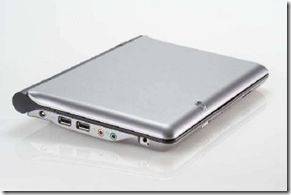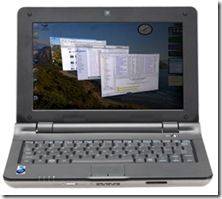Its Nanobook version II! Bigger, more powerful, more stylish, using an open-source hardware design and aimed right where Intel have left a gap. The VIA Openbook reference design that you might recognise as the Cloudbook Max, has just been launched.
The VIA OpenBook mini-note reference design introduces a host of new innovations, including the next generation of VIA Ultra Mobile Platform, based on the VIA C7®-M ULV processor and the new all-in-one VIA VX800 digital media IGP chipset. Together, this ultra compact, power efficient platform delivers richer computing and multimedia features, including a stunning 8.9 inch screen and greater video playback support, in a compact and stylish clamshell form factor that weighs just 1kg.
The VIA OpenBook features a flexible internal interface for high-speed broadband wireless connectivity that provides customers with the ability to select from a choice of WiMAXâ„¢, HSDPA and EV-DO/W-CDMA modules appropriate to their market. In addition, under a unique collaborative approach, the CAD files of the external panels of the reference design are offered for download under a Creative Commons Attribution Share Alike 3.0 license to give customers such as OEMs, system integrators, and broadband service providers greater freedom in tailoring the look and feel of their device to meet the diverse needs of their target markets.
There’s three important things to take note of here.
- The CAD files for the hardware design will be available to OEMS which will really help reduce cost and time to market.
- There are two internal module options. This provides excellent flexibility for radio options. Just slot in a new module and you have a 3G-enabled product for your market
- Not mentioned in any of the launch materials – the Isaiah upgrade path. You can bet that this was designed with Isaiah in mind and that it will scale to desktop-replacement speeds when Isaiah CPU is available as a CPU option
I see a device that can compete in the ULCPC space (XP Home, sub $500) with the VIA C7-M and the enhanced VX800 chipset and very importantly, a device that can create a brand new space for low-cost premium Vista and 3G-enabled devices when combined with an Isaiah CPU in the near future.
More analysis coming up on this later but in the meantime, you can read more information at VIA new website – www.viaopenbook.com
Update: Specs and links now being tracked in the OpenBook product page.












